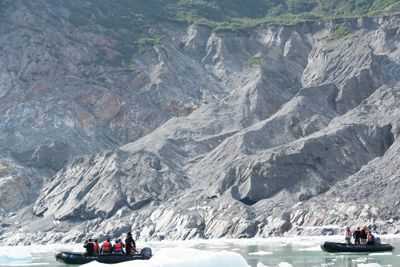Having left Juneau late last night we woke this morning near the entrance to Tracy Arm.
We approached the submerged terminal moraine at the mouth of the arm, noticing the upwelling as the moraine forced the outflowing current to the surface to make it into Stephens Passage. We spotted several whale blows in the distance. Then quite suddenly, a whale surfaced on the port bow headed in the same direction as the ship but not as fast. It was a gray whale. Gray whales range from southern Baja to the Arctic Ocean and across the Bering Sea to Russia but are not common to the Inside waters in Southeast Alaska. Naturalist Carlos Navarro commented that he had never seen a gray whale in these waters. It was a great way to start day 1 of our expedition.
About halfway into Tracy Arm we spotted the first of six bears including a pair in close proximity to each other, that we speculated were two-year-old siblings, perhaps spending another couple of summer months together before separating ways forever. The bears generally focused on eating crustaceans and rockweed in the intertidal zone along the rocky shores. Subject to verification, our expedition leader suggested that six bears in Tracy Arm in a single day might be a new expedition record.
As we approached our staging area for the Zodiac rides to South Sawyer Glacier, an increasingly dense veil of smoke moved towards us from the direction of the glacier. It was smoke. Likely smoke from wildfires burning in British Columbia. Based on the information available to us at this time, it looks to be related to a wildfire burning west of Highland Ranch in British Columbia.
On the way toward the glacier, we enjoyed sightings of a few mountain goats browsing on Sitka alder on the steep mountain slopes. We had a chance to receive some good interpretive information about the glacial processes and how it was that this incredible landscape was formed.
South Sawyer Glacier descends to tidewater from the Stikine Icefield. The Canadian border is some 18 miles east. At the glacier terminus, we enjoyed a few modest calving events from the safe distance of about 0.25 miles. Small groups of harbor seals curiously approached us, and others leisurely sunned themselves on icebergs. Fjords with tidewater glaciers offer good pupping grounds for harbor seals where they are under less pressure from killer whales, and where the abundant icebergs offer a safer alternative to the shore where bears roam.
While we watched the glacier and wildlife inhabitants, the Viking hot chocolate boat snuck up behind us and offered us a warm drink to help us endure the chilly afternoon. Mew gulls and Artic terns were coming and going from the glacier and appeared to be feeding in the upwelling at the glacier’s toe after calving events. After returning to National Geographic Venture we had an opportunity to warm and freshen up prior to recap, which included short presentations on the ice age, bears, and the iNaturalist app.
Tonight, we head toward Petersburg for some Zodiac cruises around LeConte Glacier icebergs before heading to Petersburg.









